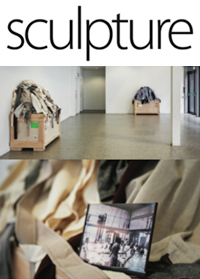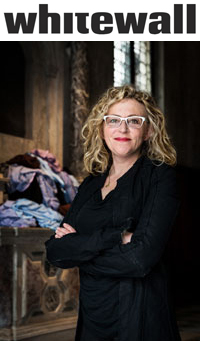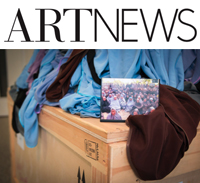Patricia Cronin / Censorship
Patricia is a visual artist and a distinguished professor of art. In 2002, she created the first marriage equality monument in the world, “Memorial to a Marriage.” The piece has been displayed in museums across the world and in the Smithsonian National Portrait Gallery in Washington DC, one of the great honors of her career.
Donald Trump’s executive order targeting the Smithsonian changed all that. It classified art that the president doesn’t approve of as un-American and woke, and vowed to re-cast the institution in his image. Not only was this a shot across the bow at the Smithsonian; as Patricia notes, it sent the message to every other art institution in America: Don’t exhibit anything that might offend Trump.
Since then, Patricia has had two solo museum shows for her work cancelled without explanation. She says this kind of censorship is particularly insidious because it doesn’t just silence the artist—it sends a broader chilling effect across the whole art community, stifling free expression and inquiry. A democracy can’t flourish if the regime is able to censor artists with impunity.
|
|
Arte.tv’s Tracks East episode “Trumps Wundersame Maga Welt
Trump face mask for relaxation? The MAGA merch store is not only a unique shopping experience for Trump fans, but also quite curious. German-American comedienne @katjanagerz assesses the hype and its dangers for us.
In the new episode of TRACKS EAST, former MAGA influencer @clarksonlawson explains why he turned away from Trump. Political scientist Rodolfo Solis looks at Latin American Republicans and what they celebrate about Trump. And artist and professor @patricia_cronin shows how MAGA seeks to restrict artistic freedom and ideologically rewrite history.
|
|
zingchat: Patricia Cronin’s Army of Love
Among the earliest monumental female nudes is Praxiteles’ “Aphrodite of Knidos,” a 4th-century BCE marble statue widely copied and reimagined throughout the ancient world. Ironically, the original was lost to history, surviving only as a ghost haunting countless echoes—from Botticelli’s “The Birth of Venus” to the legendary “Venus de Milo”—thus setting the Western canon for the female form with her sensual contrapposto and suggestive modesty. Artist Patricia Cronin’s recent body of work joins this long lineage, paying homage to the Goddess of Love, Beauty, and Grace as a heroic figure in a world that rewards hatred, destruction, and indecency.
|
|
Patricia Cronin’s Army of Love
Oracles and soldiers have something in common. When they are called up, both entities can influence the outcomes of wars, elections, natural disasters, or matters of the heart. In geopolitics, where oracles once offered guidance to political leaders, soldiers carried out the resulting orders. In Army of Love, Patricia Cronin considers how we might inhabit these roles, and think about new categories of armies that deserve support in this era of profound societal dismantling. In the exhibition, we stand at ease in the company of ancient Greek goddesses whose names are familiar, if only remembered from schoolbooks.
|
|
Memorial To A Marriage: Radical Imagination and Monumental Protest” paper in "Queer Art and Human Rights: 100 Years of Visibility and Resistance” Symposium
co-organized by the National Gallery of Ireland and Irish Museum of Modern Art, National Gallery of Ireland
10 years on: Reflecting on Art and Marriage Equality is a one-day event co-organised by IMMA and the National Gallery of Ireland. The event will focus on visual art, bringing together artists, historians, and activists to explore a century of LGBTQIA+ visibility, cultural expression, and resistance. Conceived to mark the tenth anniversary of the 2015 Marriage Equality Referendum, the focus expands to consider a broader historical and artistic perspective, acknowledging the struggles, setbacks, and victories that have shaped queer lives over the past 100 years. The event will bring together leading international voices, contributing to the ongoing LGBTQIA+ narratives and revision of history.
|
|
Patricia Cronin’s Army of Love: Ode to Aphrodite at CHART Gallery, NYC
Patricia Cronin is a groundbreaking feminist artist. Army of Love, currently showing at Chart Gallery, is representative of the boundary-pushing work she has done throughout her career. The show presents interpretations of Venus and Aphrodite statues from various periods and locations. Cronin also happened to be at the show at the time I was viewing and offered Artefuse a peek behind the curtain.
|
|
Beyond the Walls: Artist Patricia Cronin Finds Inspiration in Aphrodite
On view in New York through October 18 is Patricia Cronin’s exhibition “Army of Love” at CHART Gallery. Marking her first solo exhibition in Manhattan in nearly a decade, the show is inspired by Aphrodite. Reimagined by Cronin, the mythological figure is seen through a contemporary lens, drawing on archaeologist Iris Love’s 1969 discovery of the temple in Knidos, Turkey—once home to the storied Knidian Aphrodite by Praxiteles of Athens, the first monumental female nude that shaped depictions of the goddess of love for centuries.
|
|
Memorial To A Marriage : un monument LGBT aujourd'hui menacé
Every Thursday, Samia welcomes a guest and tells them the love story of an anonymous person. This idea is to just have a little fun - even though love is very serious. Today I tell you the story of the artist and her sculpture “Memorial To A Marriage.” This work, the first dedicated to marriage for all, is now threatened.
|
|
“Army of Love”: An Interview with Patricia Cronin
Patricia Cronin is Pygmalion recast for our unsettled present. In the classical Greek myth, Pygmalion, a young male sculptor, brings a statue of a woman, Galatea, to life—from ivory in Ovid’s Metamorphoses, from marble by the 18th century. The tale has endured as a metaphor for artistic creation and its gendered dynamics: women as largely passive objects of representation within a historically male-dominated academy. If Pygmalion’s miracle arrives only after his plea to Aphrodite, it feels apt that Cronin’s Army of Love at CHART Gallery reanimates Aphrodite and her entangled histories as a mirror for the current political moment.
|
|
NY Armory Week Shows 2025: Men and Women in Love
Army of Love, Pattie Cronin’s solo show at Manhattan’s Chart Gallery, was inspired by archeologist Iris Love’s discovery of Aphrodite’s temple in Knidos, Turkey. Cronin celebrates the queer, mythic, historic, and feminist aspects of this ancient goddess. Her unstretched paintings, as well as sculptures and watercolors, invoke the sea, site of Aphrodite’s birth, and earth. Cronin was born in 1963 in Beverly, Massachusetts and was among the first gay artists to legally marry her artist partner Deb Kass in New York City. Her Rome Prize, honors, and exhibitions are at https://www.patriciacronin.net and https:// chart-gallery.com. The Army of Love exhibition title says it all.
|
|
Patricia Cronin
CHART is honored to present Army of Love by Patricia Cronin. This exhibition marks the celebrated artist’s first solo exhibition in New York in nearly a decade. Featuring new paintings, sculptures, and watercolors, the exhibition forms a monumental installation inspired by the mythological figure of Aphrodite—the ancient goddess of love—reframing her legacy through a contemporary feminist lens.
|
|
Woke”-Kultur im Visier: Trump erhöht Druck auf US-Museen
US President Donald Trump is intensifying his stance against museums in the US. This also affects the famous Smithsonian Institution, which operates numerous museums, particularly in the capital, Washington.
|
|
Smithsonian Artists and Scholars Respond to White House List of Objectionable Art
The official White House newsletter has posted an article titled "President Trump Is Right About the Smithsonian." It calls out some of the institution's artwork, exhibitions, programs and online articles that focus on race, slavery, immigration and sexuality. That includes works at the Smithsonian's National Museum of African American History and Culture, The National Portrait Gallery, and The National Museum of the American Latino.
|
|
American Opera Projects and NYU Tisch School of the Arts’ Graduate Musical Theater Writing Program & Department of Design for Stage & Film present “The Woodlawn Operas”
Styx & Stones, a 30 minute opera by Composer Kat Cartusciello and Librettist Jessie Field was inspired by Patricia Cronin’s Memorial To A Marriage. Every day is the same for Charon, who ferries newly deceased souls across the River Styx (if they can pay, that is). Until Penelope and Donna, an old married couple, wash up on the shore of the Styx together. When they realize only Donna is able to pay the fare to cross, they attempt to move death itself with their love so that they may cross together. Inspired by Patricia Cronin's Woodlawn Cemetery monument "Memorial to a Marriage," "Styx & Stones" mourns time, celebrates love & marriage equality, and existentially investigates death. Donna / Kelly Glyptis, Soprano
PERFORMANCES were held on May 16th & 17th at the African Grove Theatre, New York, NY and May 20th, Woolworth Chapel, Woodlawn Cemetery, Bronx, NY
|
|
Patricia Cronin talks about Harriet Hosmer, the inspiration behind her new series of prints
In Patricia Cronin’s work, traditional forms of art making—oil painting, sculpture, and watercolor, for instance—are the channels through which she addresses various contemporary political issues. Cronin first gained recognition in the 1990s for a series of performance-based photographs and watercolors depicting the artist in the act of love making with her partner, and since then, she has continued to develop a sophisticated and dynamic artistic practice. The New York-based artist’s themes take in homosexuality, feminism, the body, sex, class, and art history. She has expressed these themes in conjunction with historical and mythological figures such as Dante Alighieri and Aphrodite.
|
|
"The Body Politic" Panel with Marilyn Minter, moderated by Rujeko Hockley, for Art Takeover for International Women’s Day
|
|
"The First Democracy”
THE LOCAL COLLECTION Installed across the 9th and penthouse floors is a collection of 23 artists who are born, based or trained in the city and its surroundings. This includes several solo presentations, with entire rooms dedicated to site-specific presentations of artists, such as the Lincoln Foyer’s three frescoed paintings by Eric Uhlir, Kaia’s six surrealist canvases by Zhivago Duncan and a rooftop ceiling mural by Rose Jaffe. THE FIRST 47 A thought-provoking exploration of gender representation, ‘The First 47’ features works by 47 women artists. To date there will have been 47 Presidents in the history of the United States. 47 of these have been men and zero women. This collection inverts these numbers, presenting the work of 47 U.S.-based women artists and zero men. The collection includes some of the most established museum-level artists working in the country today including key works from Judy Chicago, Catherine Opie, Marilyn Minter, Ellen Gallagher, Deborah Roberts, Guerilla Girls and Jenny Holzer, with pieces spanning various mediums including painting, textiles, photography, sculpture and mixed media. The collection includes a site-specific commission by New York-based artist Patricia Cronin in The Gallery which features classical imagery of Aphrodite and points to the first democracy in Greece. The First 47 is displayed in the lobby and continues across the entire tenth floor and each work is numbered. This is one of very few locations with such a focus on women artists and pays homage to the city’s nearby National Museum of Women in The Arts – the first museum in the world dedicated to female artists." |
|
Past as Prologue:
Part I of Past as Prologue highlighted artistic movements prominent in the Academy’s collection - 19th century genre painting, landscape, and portraiture - that contributed to U.S. nation building. Positioned in dialogue with artworks critically engaged with the politics of extraction, of both land and culture, Part I served as a call and response between history and present. Starting with works from the early 20th century, Past as Prologue Part II examines how artists have envisioned a more expansive notion of cultural identity, through artworks imbued with the values of activist movements that have recast this country’s political landscape over the last century.
|
|
Episode 39: Patricia Cronin
|
|
191st Annual: Academy Style (co-curated by Sara Reisman, Chief Curator, and Natalia Viera Salgado, Associate Curator)
The National Academy of Design's Annual Exhibition is the longest-running serial exhibition of contemporary art and architecture in the United States. The 191st Annual: Academy Style will feature work by 117 National Academicians and is the first in-person Annual held since 2015 and the first in the Academy's new home in Chelsea. Founded nearly 200 years ago in 1825, ‘Academy Style’ at the National Academy has undergone many transformations over the years. Today ‘Academy Style’ is diverse in practice, decidedly contemporary (members were invited to submit works made in the last three years), and reflective of an institutional identity and ethos initiated and led by artists and architects. In the earliest years of the National Academy, the artwork produced by the membership followed the English tradition in both style and method, with an emphasis on painting focused on history, landscape, and portraiture. The Academy initially engaged with the ‘arts of design’ as defined in 1825 to include painting, drawing, architecture, sculpture, and engraving. Now, nearly 200 years later, more recently elected Academicians work in mediums that had not yet entered the Western canon when the National Academy was founded: installation, moving image, printmaking, digital art and socially engaged art and architecture, among others – all examples of 21st Century ‘Academy Style.’
|
|
Memorial To A Marriage is one of The New York Times Must Sees for Pride!
Patricia Cronin’s sculpture “Memorial to a Marriage” depicts her and her wife, Deborah Kass (both still living). It was originally installed in 2002, in marble, on a burial plot the sculptor purchased at Woodlawn before same-sex marriage was legalized in the United States.
|
|
Digital Stone Project Residency with Garfagnana Innovazione
The Digital Stone Project is a non-profit 501c3 dedicated to enabling artists to work amazing materials and fabrication processes. Each year The Digital Stone Project and Garfagnana Innovazione work together to bring an international cohort of artists, architects, designers, educators and students to the historic Garfagnana region of Italy. While in Italy, participants gain experience working with high technology and ancient Tuscan stone. During the month-long Residency, participants are giving the opportunity to produce work carved using a combination of robotic manufacturing technologies and traditional hand-carving tools. Our partner, Garfagnana Innovazione, offers participants a unique opportunity to employ the latest innovations in digital stone carving. As an incubator of new techniques, the Residency provides a wide range of professional development opportunities focused on technology and materials.
|
|
Cronin’s FIRST published prints
Benefit Print Project is pleased to announce the pre-publication of a new project by Patricia Cronin. The project, Memorial To A Marriage, was begun in the twentieth-anniversary year of the artist’s groundbreaking marble sculpture of the same name in New York’s Woodlawn Cemetery in the Bronx (2002). It reconceives in the graphic arts the sculpture; paradoxically, although not occupying physical space, numerous new perspectives are revealed, as the two prints that compose the project give form to the invisible in ethereal and uncanny ways. Both prints are included in the National Academy's 191st Annual: Academy Style exhibition through September 14 2024.
|
|
Retinal Hysteria (curated by Robert Storr)
Beginning November 16, 2023, Venus Over Manhattan will present "Retinal Hysteria," an expansive two-venue exhibition curated by Robert Storr, who was previously Senior Curator in the Department of Painting and Sculpture at the Museum of Modern Art, and Dean of the Yale University School of Art.
|
|
Friends and Lovers
Friends & Lovers is an expansive group exhibition that centers on relationships between artists and their subjects and explores the infinite ways, both past and present, we are influenced by our inner circles. Just as a studio visit opens a window into an artist’s creative process, who they choose to immortalize through paint, bronze, photography, etc. similarly provides insight into who serves as their inspiration, be that a lover, partner, family member, friend, celebrity crush, or a fleeting encounter. Patricia Cronin’s Memorial to a Marriage, modeled 2002, cast 2015, was created at a time when same-sex marriage was illegal in the U.S. Depicting Cronin and her partner, fellow artist Deborah Kass, lying in bed, embraced in each other's arms, Memorial to a Marriage is equal parts a protest, a love letter, and a headstone for their burial plot in Woodlawn Cemetery.
|
|
The world’s first LGBTQ+ VR Museum is pleased to announce Patricia Cronin, as the Artistic Director of the Award Winning museum
Patricia Cronin is New York based award winning interdisciplinary visual artist whose paintings, sculptures and public art examine issues of gender, sexuality, and social justice. In 2002, Cronin created Memorial To A Marriage, the world’s first Marriage Equality monument and it is the centrepiece of the LGBTQ+ VR Museum. Cronin’s work has been exhibited widely in the U.S. and internationally, including Shrine For Girls at the 56th Venice Biennale, Italy that traveled to The FLAG Art Foundation, New York, the LAB Gallery, Dublin, Ireland and Catherijne Convent Museum, Utrecht, The Netherlands. Other solo exhibitions were presented at the American Academy in Rome, Rome, Italy, Capitoline Museum’s Centrale Montemartini Museum, Rome, Italy, Newcomb Art Museum, New Orleans, LA, Brooklyn Museum, Brooklyn, NY, and the Tampa Museum of Art, Tampa, FL. Cronin is the recipient of numerous awards including: the Rome Prize from the American Academy in Rome, Louis Comfort Tiffany Foundation Award, and Civitella Ranieri Fellowship. Her work is in the permanent collections of the National Gallery of Art and Smithsonian National Portrait Gallery, Washington, DC; and Kelvingrove Art Galleries and Museum, Glasgow, Scotland, Perez Art Museum Miami, FL, and Tampa Museum of Art, Tampa, FL, among others. She is Distinguished Professor of Art at Brooklyn College of The City University of New York.
|
|
CUNY Board of Trustees Names Three Brooklyn College Faculty Members Distinguished Professors
Patricia Cronin, Jason Eckardt, and David Grubbs earn the highest academic honor that CUNY can offer faculty who demonstrate outstanding merit and accomplishment in their field. Brooklyn College is proud to announce that three professors from the School of Visual, Media and Performing Arts—Patricia Cronin, David Grubbs, and Jason Eckardt—have been designated Distinguished Professors by the CUNY Board of Trustees, the highest academic honor that CUNY can offer faculty.
|
|
Brooklyn's 50 Most Fascinating People 2023
Why we’re fascinated: Because for decades she has been challenging viewers to confront their assumptions about women’s experiences. Cronin is best known for “Memorial to a Marriage” at Woodlawn Cemetery in the Bronx, a bronze mortuary sculpture created when same-sex marriage was still illegal. It depicts Cronin with her wife, embracing beneath a bedsheet, and sits atop their future burial plot. Arguably the “world’s first marriage equality monument,” it is both intimate and epic. More recent works — like “Shrine for Girls,” which commemorates three groups of young martyrs, and “Aphrodite Reimagined,” inspired by a fragmentary first-century broken torso of the goddess — provide vital commentary on how we understand the narratives around women’s histories and bodies.
|
|
Full programme announced for 37th BFI Flare: London LGBTQIA+ Film Festival 2023
Over the first four days of the festival, we will be presenting BFI Flare Expanded – a selection of four immersive art and virtual reality works from boundary-pushing LGBTQIA+ artists, working across emerging technologies such as interactive virtual reality, screen-based installations and 3D-scanning. Exploring themes of identity, belonging, self- expression and vulnerability, these powerful and visionary works aim to shift perspectives and give new insight into our increasingly complex world.
|
|
BFI Flare: seven movies to see at
the UK’s biggest queer film festival
The UK’s biggest LGBTQIA+ film festival, BFI Flare, is back next month with its usual cargo of the best in new queer cinema, retro gems, talks, discussions, parties and the odd packed dancefloor. If you’re into queer cinema or just want to connect with this inclusive, welcoming community, a trip or two down to the South Bank beckons.
|
|
6 memorials built by women—and
the love stories behind them
While many fine buildings were famously constructed by men to celebrate their beloveds—from India’s Taj Mahal to Italy’s Torrechiara Castle—there are few such tributes commissioned by women. Those that do exist were built by women who had to buck tradition or challenge societal norms.
|
|
PBS World’s Greatest Cemeteries Series
Join Host/Producer Roberto Mighty and tour a National Historic Landmark. New York’s Woodlawn Cemetery is the final resting place of legends — Duke Ellington, Herman Melville, Bat Masterson, Celia Cruz, Dorothy Parker, Madame C. J. Walker, Miles Davis, Jokichi Takamine and Irving Berlin. Gilded age monuments, towering mausoleums, modern sculptures and exquisite landscaping grace this tree-lined urban oasis.
|
|
20th Anniverary of Memorial to a Marriage Recognized for having the “largest and finest collection of funerary art in the country,” The Woodlawn Cemetery (est. 1863) encourages lot owners to create personalized memorials. One of the most significant works of art in the cemetery’s collection is Memorial to A Marriage, a full-sized depiction of artist Patricia Cronin and her wife in a lovers’ embrace. Over the course of its twenty-year history, laws have changed, and culture has changed, making the sculpture the world’s first Marriage Equality monument. On Sunday, November 6th, the Woodlawn Conservancy will host a series of walks and talks to celebrate the contribution the work has made to memorial art.
|
|
A Maze Zanine, Amaze Zaning, A-Mezzaning, Meza-9
David Zwirner and Performance Space New York are pleased to present a group exhibition organized by Ei Arakawa, Kerstin Brätsch, Nicole Eisenman, and Laura Owens at the gallery’s 519 West 19th Street location in New York. They will create a living exhibition exploring the dynamics between performance and painting. The unconventional design, conceived collaboratively by the four artist-organizers, examines how time is manifested on and off the canvas and invokes both risk and serendipity.
|
|
A Look Inside Newly Opened The Ned NoMad Membership Club And Hotel Through Renowned Curator Richie Akiva
The nearly 300-piece collection spans the public and members-only spaces throughout the building and features a list of prominent names from the New York art scene with a mix of museum-level talent as well as newer voices including Patricia Cronin, Rashid Johnson, Marilyn Minter, Laurie Simmons, Hank Willis Thomas, Glenn Ligon, Kevin Beasley, Cassi Namoda and Ariel Mitchell. Cronin who has several pieces in the collection including Zenobia in Chains and Beatrice Cenci tells me, “The Ned NoMad’s beautiful Beaux-Arts building is the perfect context for my watercolors of the Neo-classical marble sculptures made by the first professional female sculptor, Harriet Hosmer. Ghosts from the past updated for today when women continue to push forward to take up public space.”
|
|
The History and Future of the LGBTQ+ VR Museum
The LGBTQ+ VR Museum is home to 15 3D scanned objects with audio information, as well as 25 2D artworks with written information, all contributed by LQBTQ+ creators who wanted to tell their stories through the VR Museum. These artworks surround a lifesize 3D scan of the three-ton marble “Memorial to a Marriage” by artist Patricia Cronin depicting her and her wife Deborah Kass. “The statue … was created 20 years ago when gay marriage wasn’t legal,” Forster explained that only death documents recorded same-sex relationships at the time. “Patricia created the piece as a mortuary sculpture, as an elegant, permanent protest to ensure that her and her partner’s relationship would be acknowledged, and treated with dignity, even after their death.” The physical monument, which Forster called “the first and only LGBTQ+ marriage equality monument in the world,” is located at Woodlawn Cemetery in the Bronx on a plot pre-purchased by Cronin. Laws changed, and the couple was able to legally marry – and both are still alive. “But,” says Forster, “the piece remains an extremely important part of LGBTQ+ cultural history.” |
|
I Visited the World's First Virtual LGBTQ Museum
The LGBTQ+ VR Museum is one example of queer people carving out their own space in an often hostile world. Stepping inside the museum, the experience of entering an alternate reality transcends the technical beauty of its pristine surfaces and colourful exhibits. It’s my first time using a Meta Quest 2 headset, and its immersive quality is certainly sufficient to convince me I’m about to fall off the step to the garden outside on more than one occasion. But what’s truly remarkable is the sense of occupying a queer space which isn’t a temporary loan, when LGBTQ+ events are so often stuffed into straight-leaning dive bars, standard art venues, or otherwise makeshift DIY affairs. It’s a dedicated space, and one that you realise the UK is severely lacking after the headset comes off. Some people have waited longer than others for these moments. New York-based artist Patricia Cronin contributed a virtual rendition of the marble statue she created in 2002; titled Memorial to a Marriage, it depicts Cronin and her partner Deborah locked in an embrace to mark their love after death, at a time when they couldn’t marry. It remains the world’s first and only marriage equality monument. “The challenge of this work was to strike a balance between a high level of formal execution and pointed political protest,” she can be heard explaining in the museum. “What I couldn’t have in life, I would have forever in death.” |
|
LGBTQ + VR Museum Wins New Voices Award at Tribeca Film Festival in the Immersive Competition!
For bearing witness to ordinary and extraordinary stories that might otherwise be ignored. For creating an intuitive and compelling virtual space that opens up new possibilities for immersion and community, the New Voices Award goes to the LGBTQ+ VR
LGBTQ + VR Museum is the world's first virtual reality museum dedicated to celebrating the stories and
artwork of LGBTQ people by preserving queer personal histories. The museum contains 3D scans of
touching personal artifacts, from wedding shoes to a teddy bear, chosen by people in the LGBTQ
community and accompanied by their stories told in their own words. The in-person version presented
at Tribeca is a never-before-seen multiplayer biometric experience controlled by users’ emotions in
real-time. Project Creators: Antonia Forster and Thomas Terkildsen. Producer: Albert Millis. Key Contributor: Patricia Cronin. |
|
VR LGBTQ+ Museum
Premieres at Tribeca Film Festival
|
|
Virtual reality LGBTQ+ museum wows
art lovers at Tribeca Festival NEW YORK -- A groundbreaking exhibition at this year’s Tribeca Festival is dedicated to the LGBTQ community by collecting and preserving personal histories. A larger-than-life sculpture portrays the artist who sculpted it, Patricia Cronin, and her wife, artist Deborah Kass. It was placed at Woodlawn Cemetery 20 years ago. “So I depicted Deborah and myself with dignity,” Cronin said. “So it’s three tons of marble of the two of us.” Full-size replicas of the work, titled “Memorial to Marriage,” are in museums around the world, but now it’s also in a virtual reality one. “It makes me so proud to have the first marriage equality monument in the first VR LGBT museum,” Cronin said.
|
|
Road Trip Close to Home: National LGBTQ+ landmark Woodlawn Cemetery in the Bronx
The Woodlawn Cemetery is a designated national historic landmark. As a part of NYC Pride Month, the Woodlawn Conservancy will be hosting trolley tours to the sites of historic LGBTQ+ New Yorkers. Woodlawn Cemetery is listed as one of the many spots to visit on the NYC LGBTQ+ Historic Sites Project. The project was founded five years ago and lists 400 places where visitors can go to learn about the gay community’s impactful history and its notable figures. |
|
Women’s Work: 19th Century Women Artists and Their Legacy
‘Women’s Work’ seeks to establish the influence of handwork tradition through the work of contemporary women artists. Placing examples of traditional women’s work in conversation with the contemporary art that was directly influenced by this tradition, allows us to establish the pervasiveness of the traditional influence among contemporary artists and show the broad diversity of traditional handcraft mediums. Observing these objects side-by-side allows viewers to re-evaluate these historic works and understand them as the art objects they were always intended to be.
|
|
Danish researcher's wild virtual LGBTQ + museum has been nominated for a prestigious award
The marble statue 'Memorial of a marriage' is one of the main attractions at the LGBTQ + VR Museum. The statue, ‘Memorial to a Marriage’, was created by Patricia Cronin and shows herself and her wife, but was created back in 2002, when it was not legal to enter into a marriage with one of the same sex. “For us, the goal is to provide a space where stories from this environment can be told. It is rarely the stories of the marginalized that we get told in the classical museums, which most often make room for the stories of the white, gay, heterosexual men, «says Thomas Terkildsen and continues:
“None of us had the opportunity to make a physical museum, but we wanted to do something to unfold these stories. There, the virtual space is obvious. " |
|
E Pluribus: Out of Many: 190th Annual Exhibition In 1782 the United States adopted e pluribus unum (out of many, one) as its motto, signaling the country’s global emergence as a new, united nation comprised of thirteen different colonies with very diverse populations. Behind the Latin phrase was the great American ideal of unity through diversity, an ideal so epic in the framers’ minds that it completely disregarded the abject oppression and violence committed against indigenous, enslaved, women, immigrant, poor, and disabled Americans. As we navigate our contemporary moment and the various ways that the COVID-19 pandemic, continuous demands for social justice and racial equity, and the 2020 presidential election have manifested as vestiges of America’s inability to fully realize its initial motto, e pluribus: Out of Many, the 190th Annual Exhibition of the National Academy of Design purposely omits unum from its title to explore whether unity or oneness can truly be achieved in a nation founded upon principles that have always been inherently flawed and discriminatory when applied to its citizenry. Hence, the show asks: What new futures can we create if we end our pursuit of a mythological national unity and accept our reality as an incongruent collective? |
|
Patricia Cronin, Aphrodite and the Lure of Antiquity As the inaugural artist invited to respond to the Tampa Museum of Art’s Anquities Collection in the museum’s new bi-annual Conversations with the Collection series, Contemporary Artist Patricia Cronin was commissioned to create a new work. Focusing on a life size Aphrodite (1st c.e.) fragment, Cronin’s Aphrodite Reimagined envisioned her as a completed monumental cult statue with translucent missing parts hand sculpted and reconstructed. Sometimes appearing whole and other times with the changing light, appearing more fractured as a comment on our shifting certainties about truth and history. Additionally, Cronin created her first multi-layered acrylic assemblage paintings and glass works, addressing themes of gender, subverted historical approaches to statuary and reinvented ideas about the human, the heroic and the divine. This exhibition catalogue includes essays by Seth Pevnick, Ph.D., Chief Curator and Richard E. Perry Curator of Greek and Roman Art and an interview by Joanna Robotham, Curator of Contemporary Art. 24 color reproductions, 34 pp. |
|
Horses? CHART is pleased to present Horses?, a group exhibition exploring depictions of the horse and its related cultures in the context of contemporary art history. The exhibition features a group of thirty-four multigenerational artists, including historic works as well as pieces by contemporary artists commissioned specifically for this show. By employing diverse media and practices of representational and non-representational conventions, each artist creates their unique interpretation of this traditional subject matter On view in the exhibition will be the fifth iteration of Patricia Cronin’s seminal Tack Room, 1997-2021, a large-scale installation which premiered at White Columns (1998) reinstalled at Real Art Ways (1999), University of Buffalo Gallery (2004) and the Armory Show (2017). Tack Room is a replica of the storage/locker room area in a horse barn, filled with a plethora of equine accoutrements and paraphernalia. Within the 100 square foot room, floor to ceiling, there are works by the artist related to equine culture, postcards depicting horses painted by Degas, Delacroix, a framed print of Rosa Bonheur’s “The Horse Fair,” a whole assortment of riding equipment and clothing, centerfolds from erotic magazines, equine themed collectibles and other horse girl objects of obsession. The items in the installation are loaded with double entendres, multiple meanings highlighting the suggestive undertones that exist within much of horse culture related specifically to gender, eroticism and class. As per custom, a Patricia Cronin, Tack Room (1998) interior view, Armory Show 2017 new item will be added to the Tack Room with this 2021 installation at CHART. MORE |
|
The Miraculous: New York 58. (Woodlawn Cemetery in the Bronx) Provided with a generous grant from a private foundation, an artist creates a realistic, larger-than-life-size marble sculpture of herself and her life-partner embracing in bed, naked except for a sheet artfully draped across their midsections. The pose is inspired by Le Sommeil, Courbet’s scandalous painting of lesbian reverie, which itself was inspired by Baudelaire’s equally scandalous poem, “Femmes Damnées (Delphine et Hippolyte).” Once finished, the sculpture, which the artist titles Memorial to a Marriage, is transported to Woodlawn Cemetery in the Bronx where it is permanently installed on a plot where she and her lover plan to be buried. At this time same-sex marriage is illegal in all 50 States. “What I can’t have in life,” the artist explains in an interview, “I will have forever, in death.” MORE |
|
How a VR Museum Will Tell LGBTQ+ Stories A few years ago, Forster made waves with a TED talk on diversity in sexuality and gender in the animal kingdom by pushing back against the notion that heterosexuality and monogamy are natural norms. While Forster has since moved on from zoology research, she has forged a path that integrates LGBTQ+ advocacy into explorations of virtual reality. In her role at Unity, Forster leads regular talks on topics like VR training and 3D scanning. Forster now is aiming to launch a personal project before the end of July that unites her activism and her expertise in immersive technology. The LGBTQ+ VR museum, a first-of-its-kind exhibit, will be viewable using VR headsets like the Quest 2. The digital museum collects images of artwork from LGBTQ+ artists around the world, exhibited alongside 3D scans of real-world objects. Each object will be accompanied by an audio recording from its contributor explaining the object’s ties to their personal journey—how it was integral to their coming out, or how it was attached to a feeling of gender euphoria. MORE |
|
Mary Magdalene: The Exhibition (curated by Dr. Lieke Wijnia) From 25 June 2021 to 9 January 2022 Museum Catharijneconvent will be shining a spotlight on Mary Magdalen. This special exhibition will introduce the visitor to the rich, paradoxical and constantly evolving imagery surrounding this mysterious biblical figure. From the time of the New Testament to the present day, Mary Magdalen has proved to be an inexhaustible source of inspiration for artists. In addition to masterpieces from Museum Catharijneconvent itself there will be loans of superb works from national and international museums. We have embarked on joint ventures with the Rijksmuseum, Teylers Museum in Haarlem and the Amsterdam Museum, which will be lending us works by Albrecht Dürer, Lucas van Leyden and Ary Scheffer. We have also asked for contributions from The National Gallery in London, Tate Britain, and the Museum of Fine Arts in Boston. The exhibition will be showing visitors how Mary Magdalen appeared down the ages, with connections between Old Master and contemporary art. Works by Marlene Dumas, David LaChapelle and Patricia Cronin will be playing an important part in this broad historical sweep. MORE |
|
The Faces of Mary Magdalene: From Fallen Woman to Feminist Icon | Culture Few women are immediately recognizable by name alone in history, much less religiously. Mary Magdalene appears in all four Gospels. She was the first to see the risen Christ, and was commissioned to tell others. Represented by artists as a young woman with long loose hair, she has even starred in the so-called Golden Legend, according to which she emigrated to France thanks to divine providence. His image has been adapted to the doctrine and mentality of the time, and has reached popular culture, with reinterpretations as striking as that of the television Kim Kardashian, white dove in hand and profusion of makeup. Or that of the singer Lady Gaga, in the video of her song Judas. Strong and suffering, in ecstasy and close at the same time, Magdalena vertebrates the exhibition that opens this Friday at the Catharijneconvent Museum, a former monastery of the Order of Malta, in the Dutch city of Utrecht. The exhibition underlines for the first time the contemporary footprint of a saint whose liturgical feast – July 22 – has been a mandatory memorial since 2016 on the Roman calendar by order of Pope Francis. MORE |
|
Patricia Cronin: Aphrodite Reimagined In honor of the Tampa Museum of Art’s formal acquisition of Aphrodite Reimagined, by Patricia Cronin, join us for a special conversation between the artist and Dr. Seth Pevnick, former Chief Curator and Richard E. Perry Curator of Greek and Roman Art at TMA and currently the Curator of Greek and Roman Art at the Cleveland Museum of Art. Moderated by Dr. Branko van Oppen, Consulting Curator of Ancient Art at the Tampa Museum of Art, this conversation will explore the inspiration and creation of Cronin’s monumental sculpture of the goddess of love and beauty. |
|
Tampa Museum of Art Announces Acquisition of Aphrodite Reimagined
|
|
In Conversation with Patricia Cronin This March, in arm’s reach of that first, hopeful glimmer at the end of what has been a long and dark tunnel, we celebrate going inward—to reconnect with our imagination, our inspiration, our joy, our creativity, our power. The work in this issue represents the divine, the fantastical, the surreal, the sublime. It is a reflection of the daydreams and fantasies that sustain us through our struggles, upsets, and setbacks. As winter gives way to spring and we begin once again to venture outside of our homes and ourselves, may we keep the playful, uninhibited, inquisitive, adventurous spirit of our inner child never too far from reach. MORE |
|
The Importance of Patricia Cronin's Memorial to a Marriage The matter of representation has been explored by numerous artists, especially the ones belonging to social groups that were or still are exposed to oppression such as the queer community. Despite the fact things have changed since the 1969 Stonewalls Riots, the American society did not recognize LGBTQ+ people legally in terms of their right to practice marriage until 2015. The struggle to earn rights any person should be eligible to has been decades-long and caused different artists to articulate the situation through their work. The most illustrious example that marks an array of emotions related to systematic oppression and critical of the heteronormative gaze is the sculpture titled Memorial to a Marriage by the acclaimed American multimedia artist Patricia Cronin. MORE |
|
Art For Romantics: Romance is just as present in art as it is in literature – so for St Valentine’s Day, The Art Doctor is prescribing you a strengthening dose of the heavy stuff: true love, WITH obstacles. MORE |
|
The Power of Patricia Cronin's Please join us for our third installment of Common Ground featuring artist Patricia Cronin, and curators Cecilia Fajardo-Hill, Nur Sobers-Khan, and Jasmine Wahi with Maura Reilly for a conversation on Curatorial Activism. We will close with a poetry reading by Sara Deniz Akant. In Glasgow's Kelvingrove Art Gallery and Museum, on the upper balcony, there is a sculpture that takes most viewers by surprise. Cast in bronze, the sculpture shows a couple lying together on a soft bed, heads resting on a pillow with hair splayed around them. One figure lies flat on their back, knee bent upwards – the other dozing figure, tuned on their right side, reaches their left arm around their partner, their head cradled into their partner's shoulder. The sleeping pair are encompassed in a bedsheet, draped and twisted around their legs, revealing their feet and toes touching. MORE |
|
Patricia Cronin, Aphrodite, and the Lure of Antiquity New York based multidisciplinary artist Patricia Cronin discusses how Art History has inspired her feminist artistic practice for over 25 years. From Ancient Greek sculpture to 19th Neo-classical sculpture, from intimate watercolors to large assemblage paintings, Cronin’s aesthetic strategy breathes new life into traditional images and forms in time honored artists’ materials by injecting her specific contemporary content into them. This talk will also focus on her exhibition Patricia Cronin, Aphrodite and the Lure of Antiquity, the inaugural Conversations with the Collection series exhibition at the Tampa Museum of Art, including Aphrodite Reimagined, a 21st-century/ancient hybrid, monumental cult statue of the Goddess of Love, Aphrodite, commissioned by the museum. Cronin will discuss how exploring the past will continue to illuminate the present and forge a way forward. MORE |
|
Curatorial Activism: Please join us for our third installment of Common Ground featuring artist Patricia Cronin, and curators Cecilia Fajardo-Hill, Nur Sobers-Khan, and Jasmine Wahi with Maura Reilly for a conversation on Curatorial Activism. We will close with a poetry reading by Sara Deniz Akant. At the start of quarantine, the Brooklyn Rail asked how might we stay connected to each other in a time of self-isolation? Now we ask: How can we stay involved and engaged in upholding our civic responsibility to one another across communities? How can we deploy this community we have built through the New Social Environment— through hundreds of conversations and meals shared over the past six months—to mobilize daily action for grassroots movements, social justice and equity projects, and for the political good of our most marginalized communities across the nation? MORE |
|
Venture Out to See Seven Queer Public Artworks Across NYC This work is located in Woodlawn Cemetery in the Bronx, which is one of the city’s most beautiful cemeteries. Artist Patricia Cronindepicts herself and her partner, artist Deborah Kass, in a loving moment. It was created during a time when gay marriage was still illegal in the United States. The original marble version was installed in 2002, but, partly because of NYC pollution, it was replaced with a bronze version in 2011, the same year gay marriage was legalized in New York state. MORE |
|
"The Whole Issue of Virtuality Has Dramatically Changed" Life During Wartime: Art in the Age of Coronavirus, curated by Christian Viveros-Fauné, is the USF Contemporary Art Museum’s first online exhibition. Comprised of videos, photographs, illustrations and documentations of performances, paintings and sculptures, this exhibition is a snapshot of what artists across the globe have been creating and thinking since the beginning of the Coronavirus pandemic. MORE |
|
Patricia Cronin + Kalup Linzy Conversation This is our fourth online conversation in conjunction with the Life During Wartime: Art in the Age of Coronavirus exhibition. Participating artists Patricia Cronin and Kalup Linzy, join USFCAM Curator-at-large Christian Viveros-Faune, to talk about their current practice and works shown in the exhibition. MORE |
|
"Patricia Cronin, Lesbian Bodies in Queer Times,” Patricia Cronin is an interdisciplinary conceptual artist whose work examines issues of gender, sexuality and social justice. Cronin’s work has been exhibited widely in the U.S. and internationally, including Shrine For Girls at the 56th Venice Biennale, Venice, Italy and traveled to The FLAG Art Foundation, New York, NY and the LAB Gallery, Dublin, Ireland. Other solo exhibitions were presented at the Capitoline Museum’s Centrale Montemartini Museum, Rome, Italy; Newcomb Art Museum, New Orleans, LA; Brooklyn Museum, Brooklyn, NY; and Tampa Museum of Art, Tampa, FL. MORE |
|
Pressure Leads to Unity: In 1918, when the world was plagued by the Spanish flu, artists tried to make sense of the world around them. Edvard Munch made lonely self-portraits, while Egon Schiele drew his mentor Gustav Klimt on his deathbed. Photographers captured empty streets and ghostly cityscapes, like Morton Schamberg’s rooftop views from 1917, to hospitals shot by the California photojournalist, Edward A “Doc” Rogers. With the Covid-19 pandemic still raging on, and the world in quarantine, the online exhibition Life During Wartime: Art in the Age of the Coronavirus hosted by the University of South Florida Contemporary Art Museum, offers a window into what artists are up to right now. |
|
Life During Wartime: Art in the Age of Coronavirus Life During Wartime is the USF Contemporary Art Museum’s first major virtual exhibition. It humbly engages a select company of international artists to respond to the overwhelming realities of the crisis that has gripped the planet since March 5, the date the World Health Organization declared COVID-19 a global pandemic. The exhibition takes full advantage of one of the few outlets artists still have—the Internet—during a public health emergency recently exacerbated by the wanton murder of George Floyd by police officers in Minneapolis. It aims to mobilize sentiment, thought and activity around art and its enduring possibilities: its role as a conceptual catalyst, its ability to trigger ideas, stories, conversations, emotions, feelings and mental states. Separately and together, each artist contribution provides a picture of a planet in crisis, now further enraged and victimized by violence, but also images of hope and optimism in the face of a global emergency. The exhibition will continue to evolve with the addition of new artists and materials. |
|
Women and Migration(s) : Crisis Join NYU Washington, DC in welcoming NYU Tisch's Deb Willis and Ellyn Toscano with Cheryl Finley of Spelman's AUC Art Collective for this special DC Dialogues program on Women and Migration(s) webinar. This event is also sponsored by NYU's Office of Global Inclusion, Diversity, & Strategic Innovation. Women have been part of global and historical movements of people, to escape war, to avoid persecution, for work, for security. Women have been uprooted, stolen, trafficked, enslaved; they have been displaced from land despoiled of resources and habitats lost to extreme weather patterns and climate change. Now, in the midst of a global pandemic, displaced women can neither stay put nor return to the places from which they have fled; women are unequally in low-paid, high-risk, insecure “essential” employment, on the front lines of crisis; women are subjected to increasing violence, in domestic situations or the temporary and communal living arrangements in which women and girls in migratory situations are sheltered. |
|
Oh Love “Oh Love,” curated by FLAG’s founder Glenn Fuhrman, is the first in a series of Instagram exhibitions in which artists, friends, and collaborators organize thematic shows as visual essays. Each show features an eclectic range of artworks and objects, brought together without the restrictions of time or place. |
|
How Can We Think of Art at a Time Like This? How Can We Think of Art at a Time Like This? is an online exhibition, co-curated by Barbara Pollack and Anne Verhallen as a platform for the exchange of ideas at this time of crisis. We invited artists who are considered thought leaders, artists who struggle with futuristic pessimism, political outrage and psychic melt-downs. The invited artists have responded with unbridled enthusiasm and we will be posting new artists every day for the foreseeable future. |
|
Memorial to a Marriage: Patricia Cronin “Memorial to a Marriage” responds to Patricia Cronin’s sculpture, Memorial To A Marriage. “What I can’t have in life, I will have in death” is a quotation from Garden Castro’s “Making the Personal Monumental: A Conversation with Patricia Cronin.” This poem cites Walt Whitman’s “Crossing Brooklyn Ferry” and Phillip Larkin’s “An Arundel Tomb.” |
|
Everlasting love showcased on Woodlawn Cemetery’s ‘Stories of Love’ trolley tour When the husband of salsa sensation Celia Cruz laid her to rest at Woodlawn Cemetery in the Bronx, he envisioned honoring the Cuban icon in a private ceremony. Instead, thousands of New Yorkers showed up outside of her stately white mausoleum in July 2003— and Cruz’s partner, Pedro Knight, watched as they danced, wept and sang her melodies as he said his final goodbye. “Theirs is one of the greatest love stories here at Woodlawn,” Woodlawn Cemetery and Conservancy historian Susan Olsen said of Knight’s devotion to Cruz — one of over a dozen tales Olsen tells during the cemetery’s Valentine’s Day trolley tour. |
|
'She Was Brave, Like Me': Deborah Kass and Patricia Cronin on How Activism Sparked Their Romance, and the Art They Crave to See New York artists Deborah Kass and Patricia Cronin are easily one of the city’s most politically engaged art-world power couples—and their mutual love of politics is, in fact, how their romance began. |
|
LGBT Histories At Kelvingrove Art Gallery And Museum This bronze sculpture is a cast from an original marble sculpture made for their joint burial plot in New York. At the time it was created, same-sex marriage was not legal in the United States of America. The only way Cronin’s relationship with Kass could be legally recognised was through documents such as power of attorney, wills, health care statements which would only be enacted upon when either Kass or Cronin fell ill or died. In 2004, Cronin spoke about this sculpture being both a personal and political statement of her relationship and lesbian visibility: “I wanted something official that celebrated our life together and if all I will be officially allowed is death, I decided to make the most elegant and dignified statement I could about the end of our life together.” |
|
Botticelli Is Buried at the Feet of His Muse – and 9 Other Unusual Stories Behind Famous Artists’ Final Resting Places Patricia Cronin has got to be a project manager’s dream. While many artists have been bequeathed with elegiac monuments many years after their deaths, Cronin has already got her sepulchral future all set. In 2011, the artist installed a bronze version of Memorial to a Marriage, a sculpture that depicts her and her wife, the artist Deborah Kass, embracing in bed, at a cemetery in the Bronx. The seemingly Etruscan-inspired tomb will mark the couple’s resting place whenever the time comes (hopefully a long time from now). |
|
About Face: Stonewall, Revolt and New Queer Art This is an exhibition about metamorphosis. Fifty years after Stonewall, we’re still very much a community in progress. The traditional view, that Stonewall represents the birth of a gay and lesbian movement, couldn’t be further from the truth on at least two counts: it hardly represents the beginning and it was never just gay and lesbian. On the contrary, we have always embraced a transpolitics, in the sense of working to variously transgress, transfigure, transpose, transform, and finally, transcend a world of binary options, whether they be gay/straight, male/female, minority/majority, or conformist/nonconformist. Not for nothing were trans folk of various stripes the literal spark that ignited the Stonewall flame. This exhibition thus focuses on art in which boundaries blur, forms mutate, the natural is denaturalized, and the transgressive and transcendent are linked. In the works on view in About Face, sexuality, gender, ethnicity, and race—far from being clear categories—hybridize and overlap to the point that “queer” becomes a verb, not a noun. |
|
Mark Robbins, Patricia Cronin, and Stefan Sagmeister – Visible Body Immediately preceding the opening of the exhibition The Academic Body, which tracks the transformation of the body in art and society from 1894 to the present, Mark Robbins, curator of the exhibition and President of the American Academy in Rome, will speak with two of the artists in the exhibition, Patrica Cronin (2007 Fellow) and Stefan Sagmeiter, current Henry Wolf Graphic Designer in Residence. The conversation will be held in English. |
|
The Academic Body Since the origins of representation, the human body has been a vehicle for a variety of approaches to artistic expression. As a way of imagining the divine, as a site of ideal beauty and ruminations on mortality, or as the contested ground between nature and culture, bodies—and representations of bodies—index culture’s ideas about itself and mark the locus for the questioning and contestation of the human form. |
|
Eye to I: Self-Portraits from 1900 to Today |
|
How We Remember Today’s memorials are less about quiet contemplation of the past than direct confrontation with the present. |
|
Gifts From The Gods
For the past ten years, Seth Pevnick has used his expertise in antiques to serve as the Tampa Museum of Art’s Richard E. Perry Curator of Greek and Roman art. He holds a Ph.D in archaeology from the University of California, Los Angeles. He came to the museum in 2009 from the prestigious J. Paul Getty Museum in L.A., where he was the curatorial assistant in the department of antiques. Pevnick eventually went on to become the museum’s chief curator, a job in which he strove to connect the museum’s collection of antiques with its modern and contemporary art. Pevnick recently accepted a position as the curator of Greek and Roman art at the renowned Cleveland Museum of Art in Ohio, so he’ll be leaving Tampa in March. During his time at the Tampa Museum, he’s overseen the acquisition of countless works of art and curated numerous exhibitions, including 2018’s “Patricia Cronin, Aphrodite and the Lure of Antiquity: Conversations with the Collection.” For that exhibit, Cronin created a monumental sculpture of Aphrodite, the goddess of love, inspired by a torso of Aphrodite from the museum’s collection. The museum has acquired Aphrodite Reimagined, so Pevnick’s legacy will live on. |
|
How Artists See Themselves |
|
How has the selfie evolved? This new Portrait Gallery exhibition charts its rise, from 1900.
|
|
Shepard Fairey, Marilyn Minter, and Other Artists Share
Their Reactions to America's Divisive Midterm Elections |
|
Patricia Cronin Elected to the National Academy of Design |
|
Patricia Cronin Casts Aphrodite as a
Feminist Role Model |
|
To Draw Viewers, Museums Show That What’s Old Is
New Again |
|
Patricia Cronin : Design Matters Podcast |
|
Visual Assault |
|
Patricia Cronin brings a monumental Aphrodite
to the Tampa Museum of Art
|
|
Tampa Museum of Art Kicks off the Season of Love! |
|
Patricia Cronin, Aphrodite and the Lure of Antiquity:
Conversations with the Collection |
|
Memorial to a Marriage |
|
Patricia Cronin at The LAB Gallery |
|
"Memorial To A Marriage: Museums, Equality, and Social Justice" Gallery Talk |
|
Flag Art Foundation Celebrates Its First Decade For any successful venture, a decennial anniversary is a reflective occasion to take stock of achievements and honor the milestone, but also to ponder the future. The question often on everyone’s mind, and perhaps the most vexing for a high-caliber art venue: So what’s on tap for the next decade? |
|
Annual Recent Acquisitions Exhibition The annual exhibition "Recent Acquisitions" at the Smithsonian’s National Portrait Gallery displays the latest portraits to enter into the museum’s renowned collection. Figures who have made lasting contributions in such areas as medicine, music, literature, art and social justice are represented in paintings, sculpture, prints, drawings, photographs and new media. The latest version of the installation will be on view from Nov. 17 through Nov. 4, 2018. |
|
Prune, The Met, and BAM: Patricia Cronin's New York This week, Whitewaller New York launches for The Salon Art + Design (November 9-13). To help guide you to the best spots in town—where you can eat, drink, see art, and relax at, we hear from a group of insiders. Up next, we hear from Patricia Cronin Brooklyn College of the City University of New York. |
|
Patricia Cronin at the LAB Gallery Dublin "Patricia Cronin: Shrine for Girls, Dublin" is on view at the LAB Gallery in Dublin, Ireland, through Sunday, August 20. The solo exhibition, the New York-based artist's first in Ireland, is a re-creation of her installation at the 2015 Venice Biennale. |
|
Groups of garments go local and global
Glance through the plate glass window of the Lab on Foley Street and you’ll
find that New York-based artist Patricia Cronin has transformed the main
ground floor gallery space into a Shrine for Girls. |
|
Regarding Women in the Acton Collection Inauguration of the art exhibition by Italian and international female artists Zoe Buckman, Alessandra Capodacqua, Patricia Cronin, Bärbel Reinhard, and Deb Willis, with poetry reading by Elisa Biagini, followed by a performance by Karen E. Finley, New York-based performance artist. |
|
Patricia Cronin
Shrine For Girls,
Dublin The LAB Gallery is pleased to present, Shrine For Girls, Dublin, the first solo exhibition in Ireland of New York artist Patricia Croinin. One of the critically acclaimed highlights of the 2015 Venice Biennale, this site-specific installation is a meditation on the global plight of exploited girls and women. Moving from the sacred altars and architecture of Venice’s sixteenth-century Chiesa di San Gallo to the secular urban gallery context of The LAB, in the heart of Joyce's Nighttown and built in the shadow of the last Magdalene Laundry to close in Ireland in 1996, Cronin gathers hundreds of articles of women’s and girls’ clothing from around the world to represent three specific tragedies. Brightly-colored saris symbolize two Indian cousins who were gang-raped and lynched in 2014; somber hijabs signify 276 Nigerian Chibok schoolgirls who were kidnapped by the terrorist group Boko Haram in 2014 (109 of which are still missing); and pale aprons symbolize those worn by “fallen women” in forced labour at the Magdalene Asylums and Laundries in Ireland, the United Kingdom, Europe and the United States to act as relics of these young martyrs. |
|
Patricia Cronin: Value, Justice, and Success Patricia Cronin likes to ask three questions through her work: Whose body has value?
Who gets to decide? And what are the consequences to the individual and to the
community? |
|
"Patricia Cronin: Social Justice and Aesthetic Responsibilities" Lecture
Picturing Women Series New York based conceptual artist Patricia Cronin will discuss her work addressing social justice issues of gender, sexuality and class; including, marriage equality, feminist art history and the international human rights of women. This talk will detail three major bodies of work Memorial To A Marriage, Harriet Hosmer: A Catalogue Raisonné and Shrine For Girls. Cronin’s aesthetic strategy breathes new life into traditional art images and forms in time honored artists’ materials and injects her specific contemporary political content into them. |
|
How Should Art Address Human Rights?
The American artist Patricia Cronin has used garments to make work about human-rights violations far from where she lives in New York. She’s also sensitive to her role as an outsider creating art about other people’s suffering. “I want people to see and care about what’s happening in these distant geographic areas through the clothes that women and girls wear every day. Just like the jeans and sweaters we put on every morning,” Cronin told me. For her installation Shrine for Girls, which debuted at the 2015 Venice Biennale inside a 16th-century church, she piled clothing on each of the venue’s three marble altars to symbolize three moments of gendered violence in history. One altar held brightly colored saris and a small photograph of two teenage cousins in India who were raped and lynched the previous May. Another altar held hijabs representing the 276 Nigerian schoolgirls kidnapped by Boko Haram in 2014. On the last altar was a heap of apron-type uniforms for the tens of thousands of Irish women forced into slave-labor conditions in Catholic Church-run laundries from the 18th-to-late-20th century. |
|
Expanded Visions: Fifty Years of Collecting
Leslie-Lohman Museum of Gay and Lesbian Art
Our inaugural exhibition in the newly renovated and vastly expanded Museum space, Expanded Visions: Fifty Years of Collecting, is a historic collection show with approximately 250 works on view. Expanded Visions mines the rich cultural coffers of the Museum's collection to trace the evolution of our institution, amid decades of shifting social conditions. The exhibition presents a survey of the collection initiated by the Museum co-founders, Charles Leslie and Fritz Lohman, who have spent more than 50 years amassing artworks that speak directly to the LGBTQ experience. Their early efforts yielded one of the most unique archives of work that would have otherwise been lost or destroyed, which comprises the core of the Museum’s collection that now houses more than 30,000 objects. |
|
Shrine For Girls is featured along with Olafur Eliasson, Krzysztof Wodiczko and Rachel Whiteread in Art History text book in the last chapter "The International Scene since the 1950s"
|
|
Horsing Around: Patricia Cronin Restages "Tack Room" at The Armory Show Chaps, saddles, whips, back issues of Polo Magazine, oil paintings of horses, erotic pin-ups—this is the stuff inside artist Patricia Cronin’s Tack Room, 1997-98, a wooden barn-like installation and arch comment on horse culture, sex, and class. “With the Tack Room I simultaneously reimagine an adolescence I never had and fantasize about my future. Someday I’ll finally get to have a horse,” explains Cronin, wryly. Cronin will reprise this work at New York’s Armory Show, open March 2 through 5, where it will figure prominently in the fair’s new curated feature, Platform, which focuses on large-scale installations and site-specific works. The section is one of several fresh additions to the fair under new director Benjamin Genocchio. |
|
Revamped Armory Show draws praise and crowds The Armory Show, opening to the public today and running through 5 March at Piers 92 and 94 on the west side of Manhattan, is the subject of scrutiny this year, the first fully under new executive director Benjamin Genocchio, and he has taken pains to distinguish the fair from its global competitors. “This is not a franchise fair,” Genocchio told assembled journalists as the doors opened on Wednesday. “This is a New York institution.” Gone is the tidy chronological separation between Modern and contemporary art. Pier 92, in addition to hosting the Insights sector for focused presentations of 20th century art, gains some buzz thanks to the curated Focus section and a revamped VIP lounge (de facto segregation remains, however, in that the bigger galleries retain the prime real estate on Pier 94). Observers commented that the overall layout felt more spacious, but it remained to be seen after the VIP opening whether attendees’ pockets were equally deep; many galleries coyly reported sales in the five and low six figures, without the fanfare of years past. |
|
Women Artists to See Now It’s glorious, it’s gargantuan and it’s certainly not for the faint of (he)art. It’s Armory Week, which means New York City is awash with art fairs (including The Armory Show, for the which the week was named), as well as notable exhibitions in galleries and museums across the city. To navigate the onslaught of modern and contemporary works, we snagged one of the best guides in the biz, Bettina Prentice, founder of communications firm Prentice Cultural Communications. But no need to take our word for it. Her client list, which includes Tiffany & Co., Google, Bulgari and more, speaks for itself. Day job aside, Bettina, who is a founding member of The Artemis Council at The New Museum and who also helped produce a Vanity Fair piece on influential women gallerists, holds dear her work promoting gender equality in the art world. So in the same spirit of solidarity, here she presents four powerful women artists to watch during this week’s shows. |
|
The Stories Behind 5 of The Armory Show’s Largest Artworks It’s hard to miss The Armory Show’s new Platform section of large-scale artworks and installations. Enter the fair on Pier 92 and you’ll walk straight into Abigail DeVille’s Sarcophagus Blue (2017), a worn, wooden boat overflowing with mannequin legs in ripped tights. Kick the day off on Pier 94 and you’ll see Sebastian Errazuriz’s The awareness of uncertainty (2017), an upright piano hoisted high in the air. These are just two of the 13 Platform works sprinkled across the two piers.
Cronin’s contribution to Platform is her own take on the tack rooms found in horse stables; the installation is lined with bridles and saddles, paintings, and accessories, some more sexually suggestive than others. “You smell leather, wood, a few bales of hay; you see the riding crops, whips, chaps—it’s all there, and your mind’s eye will just fill in the rest,” Cronin said with a laugh. |
|
Horsing Around: Patricia Cronin Presents ‘Tack Room’ at the Armory Show After exiting the elevator and walking past one of the fair’s many V.I.P. lounges (this one presented by the German furniture designer Rolf Benz, for those keeping score), the first piece of art I encountered at the Pier 92 section of this year’s Armory Show was the fantastic Tack Room—a fantasy replica of the storage part of a horse stable created nearly 20 years ago by the artist Patricia Cronin and shown as part of the fair’s Eric Shiner-curated Platform section. “I was trying to be prophetic about my future—someday I’ll be a successful artist and I’ll get to finally have a horse,” Cronin, who was on hand today, said of the piece, which was first shown almost two decades ago at White Columns. When asked if she ever got that dream horse, she answered with a resounding “no,” going on to further explain that Tack Room was, among other things, a way to “relive an adolescence that I never had. I didn’t grow up with horses. Anyone who grew up with horses doesn’t need to make this,” she said with a hearty laugh. |
|
Patricia Cronin’s acclaimed 1997-8 Tack Room included in
An Incident, Eric Shiner’s curated Platform Section at The Armory Show Debuting in 2017, Platform stages large-scale artworks, installations and site-specific commissions across Piers 92 & 94. Artists and galleries are invited by an appointed curator to realize ambitious projects that activate the fair’s unique industrial space. The 2017 edition of Platform, entitled An Incident and curated by Eric Shiner, features twelve internationally acclaimed artists: Participating artists include: Abel Barroso, Patricia Cronin, Douglas Coupland, Abigail DeVille, Sebastian Errazuriz, Dorian Gaudin, Jun Kaneko, Per Kirkeby, Yayoi Kusama, Iván Navarro, Evan Roth, Fiete Stolte, Lawrence Weiner and Ai Weiwei. Patricia Cronin will restage her acclaimed 1997-98 mixed media installation, Tack Room, which presents equestrian equipment and paraphernalia with oil paintings and bronze sculptures creating an erotically charged environment that addresses female autonomy, desire, power and class. |
|
Panel Discussion | A Conversation on Tack, Whack and Quack
PARTICIPANTS: MODERATOR: |
|
Eric Shiner Curates Large-Scale Installations and Site-Specific Commissions for The Armory Show The Armory Show returns to Pier 92 & 94 this week, open to the public from March 2-5. With 210 exhibitors, the fair will debut a new series entitled “Platform,” a staging of large-scale works, installations, and site-specific commissions curated by Eric Shiner, the Senior Vice President of Contemporary Art at Sotheby’s. Whitewall spoke Shiner about curating the Platform exhibition “An Incident” for The Armory Show, which includes art from Abel Barroso, Patricia Cronin, Douglas Coupland, Abigail DeVille, Sebastian Errazuriz, Dorian Gaudin, Jun Kaneko, Per Kirkeby, Yayoi Kusama, Iván Navarro, Evan Roth, Fiete Stolte, Lawrence Weiner and Ai Weiwei. |
|
Sotheby's Eric Shriner to Curate Section of Large-Scale Works at Armory The 2017 edition of the Armory Show is going big. The fair will see the launch of a new, curated exhibitor section called Platform dedicated to large-scale artworks and installations, and site-specific commissions installed across Piers 92 & 94. The inaugural edition of Platform, titled “An Incident,” is curated by Eric Shiner, senior vice president of Contemporary Art at Sotheby’s. Shiner, an expert on Andy Warhol and Asian contemporary art, served as director of the Andy Warhol Museum in Pittsburgh from 2010 to 2016. The first edition will feature works by 12 renowned artists: Abel Barroso, Patricia Cronin, Douglas Coupland, Olga de Amaral, Dorian Gaudin, Jun Kaneko, Per Kirkeby, Yayoi Kusama, Iván Navarro, Fiete Stolte, Lawrence Weiner, and Ai Weiwei. |
|
What Artists Can Learn From Teaching There’s a mountain of evidence that arts education is valuable, even transformational, for all sorts of students, from young children to inmates at Rikers. It has been shown to improve emotional regulation, teamwork, and academic performance. Under the right circumstances, it can even act as a catalyst for social justice. But flip the script: How does teaching influence teachers? Whether it’s critiquing an MFA painting class, giving a museum tour to a group of six graders, or leading a drawing workshop for developmentally disabled adults, working artists are often at the front lines of arts education. Many see teaching as a valuable practice, beyond simply a means of financial support. It may even shape how they approach their art practices. Below, six artists weigh in with the lessons they’ve learned from their work as educators. Patricia Cronin, artist and professor at Brooklyn College, teaches undergraduates from all over the world. “Ninety percent are immigrants or first-generation Americans, living in multigenerational households, and almost all are the first person in their families to go to college,” Cronin says via email. “Their stories of struggle, commitment, and courage really move me.” It follows that Shrine For Girls, her installation that began at the 2015 Venice Biennale, was a meditation on the global exploitation of girls and women. In many ways, courage is Cronin’s watchword, which she passes on to her students: “No one ever talks about how brave you have to be every day in your studio.” Leading by example, her own work often boldly addresses female sexuality. “Making radical, singular works is what art is about,” she says. “Artists aren’t supposed to be herd animals; that’s for accountants.” |
|
Here’s What Artists Have to Say About the Future of America Under Donald Trump In the wake of the election of Donald Trump to the US presidency, artnet News has reached out to a number of artists for their thoughts on the event and its potential effects—within the arts, the nation, and the world at large. For some artists, the election’s unexpected outcome was still too raw, the perceived wound too fresh, for them to put their emotions into words. For others, the chance to reflect on Hillary Clinton’s loss and its ramifications was a chance for catharsis. This means that, for many, the healing power of the arts can offer a way forward as we look to fix a deeply divided and possibly broken nation. Here is what they had to say. |
|
The Women Who Championed Sexually Explicit Art in the '90s Are Relevant as Ever They returned to New York that fall and scoured the city for fellow female artists working in the same vein. Two years later, their efforts culminated in a 1993 group show at David Zwirner, “Coming to Power: 25 Years of Sexually X-Plicit Art By Women.” This fall, the pioneering feminist show is seeing a revival, with new curators, Pati Hertling and Julie Tolentino, a new gallery, Maccarone in New York, and a fresh performance program of queer and trans artists. Did the show have an impact in its own time? And how has creating sexually explicit art changed for women artists in the 23 years since? |
|
How X-Rated Feminist Art Came Into Power Slick, drooping phallic forms by Louise Bourgeois hung from the ceilings, while Joan Semmel’s psychedelic-colored sex paintings were mounted on the walls. Wads of rolled-up gum arranged by Hannah Wilke resembled disembodied vaginas, while Nancy Fried’s sculpted scenes of erotically charged lesbian domesticity, upon closer look, revealed themselves to be carved out of bread. |
|
Coming To Power: 25 Years of Sexually X-plicit Art by Women
Instigated by Cantor’s vision, COMING TO POWER reflected the bold voices and urgency of iconic female artists’ work from the 60-70’s, pop and porn of the 80’s, and collided with early 90’s sex positive, queer, BDSM, and sex radicals of performance and video art culture. |
MACCARONE |
Kansas City's Grand Arts Releases a Book on 20 Years of Art, Science, and Tech
|
|
PATRICIA CRONIN
Shrine for Girls, New York |
|
Patricia Cronin: Shrine for Girls, New York An exhibition whose subject matter is the “global plight of exploited girls and women who have been victimized, brutally silenced, and written out of history simply because of their gender” is, from a moral point of view, beyond criticism. |
|
Talk: Patricia Cronin and Maura Reilly at FLAG Art Foundation At this talk, artist Patricia Cronin will discuss her current show at the FLAG Art Foundation with curator Maura Reilly. Cronin’s FLAG show, “Shrine for Girls, New York,” is an installation that was initially shown at the 2015 Venice Biennale. In it, piles of clothes on wood crates represent various exploited women—hijabs symbolize the 276 girls that Boko Haram kidnapped in 2014, for example. Though specifically referring to events around the world, the works also more universally allude to the abused, “fallen women,” in the artist’s words, that appear in almost every country, on every continent. |
|
Patricia Cronin in conversation with Maura Reilly Please join us for a conversation with Patricia Cronin Creator of Shrine for Girls, on view at The FLAG Art Foundation & Maura Reilly Director of the National Academy Museum, and Co-curator with Linda Nochlin of Global Feminisms at the Brooklyn Museum, 2007. RSVP REQUIRED: rsvp@flagartfoundation.org |
|
MUST SEE NEW YORK |
|
18 Female Artists Give Advice to Women Starting Out in the Art World The gap in gender equality ranges from the not-so-subtle dominance of male artists at gallery and museum shows to the outright misogyny of an artist like Georg Baselitz, who has openly stated, “it’s a fact that very few of them succeed,” when referring to female artists. Amid much-hyped headlines about works that have broken the $100-million mark at auction—10 artworks to date—not a single one is by a female artist. “Unfortunately, there is no gender equity anywhere right now—and the art world is no exception,” said Janice Sands, executive director of Pen and Brush, a nonprofit space started in 1893 that offers female writers and artists a space to create and show their work. “Many young women artists who are going out there and really trying to make a living at this may not be thinking about gender at all,” said Sands. “They are thinking about whether they can find a gallery to show their art, get representation, sell their work.” With this often discouraging contemporary art world backdrop in mind, we sought the advice—and inspiration—of a group of established female artists to see what crucial wisdom and tips they would impart to the next generation. |
|
The Cultivist : Summer Soltice with Shrine for Girls
|
|
POIGNANT & POWERFUL: TOME RESORT 2017 Ryan Lobo and Ramon Martin of TOME first saw artist Patricia Cronin’s Shrine for Girls at the Venice Biennale in 2015. The powerful installation commemorates three tragedies in recent times where women fell victim to suffering and exploitation. Honouring the female lives lost in India, Nigeria and Ireland, the piece arranges the colourful saris, hijabs and uniforms of these victims of murder, kidnapping and forced labour into piles on stone alters at Venice’s 16th century Church of San Gallo. Paying tribute to Cronin’s poignant work, the TOME design duo drew inspiration from the installation to create a metaphorical interpretation of the three shrines in homage to the women through ‘abstraction of details and exploration of colours representative of different cultures and believes.’ |
|
Yale University School of Art at Norfolk 2016 Lecture Series |
|
TOME Ramon Martin and Ryan Lobo typically look to a female artist for inspiration when they’re designing their collections for Tome; it’s much rarer that the artist looks back. But such was the case on Tuesday, when Lobo took this reviewer on a tour of The FLAG Art Foundation’s exhibition of Patricia Cronin’s “Shrine for Girls,” which he and Martin had initially seen at the 56th International Art Exhibition at the Venice Biennale. Cronin, who was on hand at the gallery (and later at Tome’s studio) to discuss her work, was inspired by three recent tragedies that had to do with the global plight of exploited women—the 276 Nigerian Chibok schoolgirls who were kidnapped by Boko Haram in 2014; two teenage Indian girls who were gang-raped, and lynched at the edge of their village, Katra Sahadatganj, in 2014; and the “fallen” women who worked in forced labor during the 20th century at Ireland's Magdalene asylums and laundries (memorably shown in the 2013 film Philomena). |
|
TOME Ryan Lobo and Ramon Martin first laid eyes on Patricia Cronin’s heartbreaking installation, “Shrine for Girls,” at the Venice Biennale last year. (It just opened at New York’s Flag Art Foundation, just a few blocks from Tome’s studio.) The work, a meditation on trafficked women, features three fabric sculptures on top of shipping crates, with piles of clothes representing missing victims. “The emotional weight of clothing is something that Ryan and I always talk about,” said Lobo during a walk-through of the exhibit. “And to see an artist elevate that beyond what fashion can do is a really inspiring thing.” |
|
Fashion label TOME's Resort '17 line inspired |
|
Patricia Cronin's Complications |
|
MUSEUM ACQUISITION |
|
Editors' Picks: 10 Art Events to See in New York This Week |
|
The Mark Grote Annual Artist Lecture Series Patricia Cronin’s dramatic sculptures, paintings and installations subvert art historical images and forms with contemporary political content. Cronin’s artwork and writing examine issues surrounding gender, sexuality and social justice. Most recently her project Shrine For Girls, Venice, a reflection on the global plight of exploited women and girls, attracted both huge crowds and widespread critical praise at the 56th international Venice Biennale in Venice, Italy. Cronin’s work has been widely exhibited both in the United States and abroad, and examples may be found in the permanent collections of major museums, including the Perez Art Museum in Miami and the National Gallery of Art in Washington, DC. Recipient of numerous prestigious awards and fellowships, including the Rome Prize of the American Academy in Rome and the Anonymous Was A Woman Award, Cronin is also the author of Harriet Hosmer: Lost and Found, A Catalogue Raisonne (Charta, 2009) and The Zenobia Scandal: A Meditation on Male Jealousy (Zing Books, 2013). |
|
Artwalk NY The 21st annual ARTWALK NY took place November 17, 2015. We were thrilled to honor Artist Honorees Deborah Kass and Patricia Cronin and Philanthropic Honorees Alec and Hilaria Baldwin and Richard Gere. |
|
Catalogue Launch: Shrine for Girls, Venice To celebrate the publication of Shrine for Girls, Venice, a Rail Curatorial Project and Collateral Event of the 56th Venice Biennale, artist Patricia Cronin will be in conversation with Maura Reilly, art historian and Chief Curator at the National Academy Museum in New York.
|
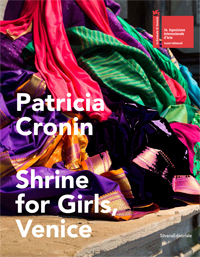 |
Shrine for Girls, Venice
Although the United Nations passed the Universal Declaration of Human Rights in 1948, women and girls around the world continue to be among the most vulnerable members of our global society. Often facing violence, repression, and enforced ignorance, this young female populace is subjected to a horrifying existence on earth. |
|
11 Artists Who Helped Pave the Way to Marriage Equality Exploring her own homosexuality as a theoretical concept, Cronin took on her experience as a married lesbian for her tender and bold Memorial to a Marriage (2002). The bronze sculpture features her and her wife, artist Deborah Kass, locked in an eternal embrace, memorializing their marriage that occurred the day same-sex marriage was legalized in New York. The title qualifies the monument: opposing those that might argue if this is a marriage at all, this is not a memorial to marriage, itself, but to a marriage; the individualization of Cronin and Kass’s lived experience is instrumental to understanding the emotional and potentially political impact of the work. |
|
Marriage Equality for All! #LoveWins Today is a wonderful day for equality, as LGBTQ couples are now able to marry anywhere in the United States just like their heterosexual peers. It is no longer “gay marriage” but simply marriage, which is how it should’ve always been.
|
|
Patricia Cronin : 'A silent protest can be quite powerful'
|
|
Venice Biennale Expands Its Scope “In New York, everyone is distracted by the art market and the auction houses,” said the American artist, Patricia Cronin, whose installation, “Shrine for Girls,” is on view in the deconsecrated church of San Gallo, near the San Marco square. “Once you get into the international art world, political art is important.” |
|
Patricia Cronin And The Body Politic About a year ago, artist Patricia Cronin was on a plane bound for Italy when she found herself sobbing through Philomena, the 2013 biopic starring Judi Denchas a woman searching for her son, whom she was forced by nuns at an Irish convent to give up for adoption. Once in Italy, she read about the mass kidnapping of Nigerian schoolgirls by the Islamic extremist group Boko Haram, and, a short time later, about two young female cousins in India found hanging from a mango tree. |
|
Heartbreaking 'Shrine For Girls' Pays Tribute To Young Female Martyrs Around The World "At first, it's deceptively simple," artist Patricia Cronin explained to The Huffington Post. "But then you start to think 'Oh, there really should be a girl inside this hijab.'"
|
|
Artist Patricia Cronin Dedicates Altars to Suffering Girls at Venice Biennale During the Venice Biennale, a special project by the New York-based artist Patricia Cronin will commemorate the women and young girls around the world who face constant violence and repression, especially—but not only—in India and Nigeria.
|
|
National Gallery of Art Announces Historic Acquisition of More Than 6,000 Works of Art from the Corcoran Gallery of Art
Includes two Cronin watercolors from her Hosmer Lost and Found Series Earl A. Powell III, director, and Franklin Kelly, deputy director and chief curator, National Gallery of Art, announced today that 6,430 works of art have been selected initially from more than 17,000 Corcoran works in the Gallery's custody to join the nation's collection of European and American art. As curators continue to review the collection of the Corcoran Gallery of Art, the newly accessioned objects will have an immediate impact across NGA's collections and will be particularly transformative for its holdings of American art in all media. |
|
Global Positioning Systems Global Positioning Systems is the second iteration of Pérez Art Museum Miami’s Overview Galleries, in which selections from PAMM’s permanent collection are displayed alongside loans from important private collections. Consisting of six interrelated parts (titled History Painting, Visual Memory, The Uses of History, Urban Imaginaries, The Contested Present, and Forms of Commemoration), this thematic group presentation explores the intersection between globalization and history. Since the late 1980s, the political and economic forces unleashed at the close of the Cold War have combined with dramatic advances in transportation and digital communications to create an unprecedented degree of interdependency among the nations of the world. |
|
The Classical Nude and the Making of Queer History The Classical Nude and the Making of Queer History, curated by scholar Jonathan David Katz, investigates the continued centrality of the classical nude over centuries of art making. This exhibition explores how images of the classical past have acted as recurring touchstones in the historical development of same-sex representation, and as such, constitute a sensitive barometer of the shifting constructions of what we today call gay and lesbian or queer culture. The classical past is thus gay culture’s central origin myth, and its representation offers far more information about the culture that appropriates the classical past then it does about that past itself. In tracing this trajectory of the classical nude across history, this show concentrates on four major periods: Antiquity, the Renaissance, the eighteenth and nineteenth centuries, and the modern/contemporary periods. |
|
Jeffrey Deitch Has Big Plans Now That He's Left Los Angeles In the years before the Manhattan galleries left the quaint cobblestones of SoHo and moved north like so many displaced people to the wide streets of West Chelsea, Deitch Projects was a one-of-a-kind gallery. It opened in 1996 in a garagelike space on Grand Street, and its exhibitions seemed less about the quest for masterpieces than about mashing up art with graffiti, cartooning, video, punk rock and especially performance. In 1997, the Ukrainian artist Oleg Kulik lived in the gallery for two weeks as a caged dog, wearing nothing but a studded dog collar and crawling around on all fours.
|
|
‘Crossing Brooklyn,’ Local Talent at Brooklyn Museum From left, Austin Fremont, Patricia Cronin, and Deborah Kass, all of Brooklyn, dancing to Nina Katchadourian’s video installation “In a Room Full of Strangers.” |
|
Sylvan Cemetery: Architecture, Art & Landscape at Woodlawn Sylvan Cemetery: Architecture, Art and Landscape at Woodlawn coincides with Woodlawn's 150th anniversary celebration, and is an outgrowth of the Cemetery's 2006 gift of its archive—the most complete set of 19th– and 20th–century cemetery records held in the public trust–to the Avery Architectural and Fine Arts Library at Columbia University. The exhibition marks the first time selections from this archive will be displayed. |
|
Exhuming the Artistic Afterlife
from One of NYC’s Historic Cemeteries Up in the Bronx, at the end of the line of the 4 train, is a “remarkable museum of American funerary art,” as the wall text for Sylvan Cemetery: Architecture, Art and Landscape at Woodlawn at Columbia University’s Miriam and Ira D. Wallach Art Gallery puts it. That “remarkable museum” is Woodlawn Cemetery, and the exhibition makes a case for it as a major resource of architecture and decorative arts history in New York City. |
|
Til Death Do Us Part "This is the first piece of real estate I bought, and it will be my last,” says artist Patricia Cronin, referring to the plot she purchased at Woodlawn Cemetery in the Bronx. “I have it into perpetuity.” When Cronin and her spouse, artist Deborah Kass, are eventually laid to rest, they—or at least, the walking living—will be within strolling distance of J. P. Morgan, Miles Davis, Duke Ellington, and Celia Cruz. |
|
Designs That Outlived Their Benefactors Woodlawn Cemetery, a national historic landmark in the Bronx that turned 150 last year, is celebrating with an exhibition on its spectacular Gilded Age tombs. “Sylvan Cemetery: Architecture, Art and Landscape at Woodlawn,” which opens on Sept. 3 at the Miriam and Ira D. Wallach Art Gallery at Columbia University, will offer a display of ironwork, sculpture, stained glass and furniture from the mausoleums along with records from the cemetery’s voluminous archives, which were transferred to Columbia in 2006. |
|
It Begins With Paper Its debut exhibition It Begins on Paper, will feature a group show drawn from artists on the gallery’s roster and beyond, featuring exclusively, and examining the nature of works on paper: its status as the typical first medium employed by an artist, its fragility, its historic use for disseminating ideas and information. Selected works include two large watercolors by Patricia Cronin (a mother of the relationship between feminism and contemporary art) from a series inspired by Dante’s Inferno, in which human figures, made organic by the watercolor process, portray agony and ecstasy in purple and crimson washes. |
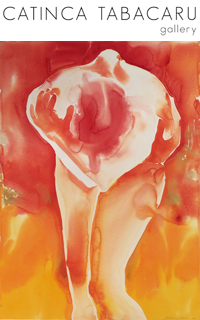 |
Look At Me: Portraiture From Manet to the Present The inaugural exhibition, Look at Me: Portraiture from Manet to the Present, spans a vast historical period of 150+ years from Manet to the present, and explores perhaps the broadest and most practiced genre in art history. Throughout time, mankind’s preoccupation with the self - one’s appearance, perception and ultimate identity ‐ has influenced artists to create, and individuals to commission, portraits. Portraits have been an indispensable way of communicating identity, with real as well as symbolic meaning for centuries of art audiences. Look At Me celebrates and explores portraiture in recent history and investigate how artists today are engaging with the broad spectrum of descriptive strategies . |
 |
Deja Zing : Patricia Cronin Takes A View From Above In "Luxury Real Estate Paintings" Where is the boundary between art and voyeurism? Patricia Cronin launched a career based on the inquiry of power and gaze when she first showed her “Erotic Polaroids” at David Zwirner in a group exhibit in 1993. The photos depicted various X-rated scenes including men subjugated as erotic objects in S&M games in one sequence as well as queer women engaged in sexual acts with a Madonna cardboard cutout, from the perspective of the artist herself as a participant. |
 |
Ghosts in the Machine Lecture New York based artist Patricia Cronin will present a lecture on her recent work titled Ghosts in the Machine. Event is open to the public.
|
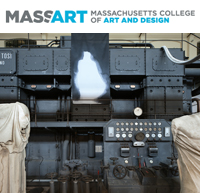 |
Patricia Cronin's Recent Publications Honored Patricia Cronin's two recent publications were honored at the Brooklyn College Library's Annual Book Party celebrating Brooklyn College faculty authors.
|
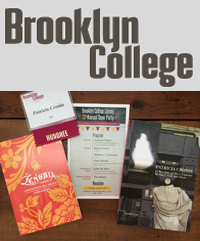 |
Memorial to a Marriage featured on Chelsea Handler Show |
|
Ghosts in the Machine Please join us at Noon on Thursday, March 20, in the National Portrait Gallery’s boardroom for a presentation by New York based conceptual artist Patricia Cronin. She will be speaking about her latest body of work “Ghosts in the Machine.” |
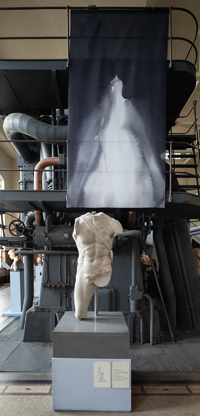 |
The Last Brucennial Patricia Cronin included in The Last Brucennial Vito Schnabel & Bruce High Quality Foundation New York, NY March 7 - April 4, 2014 |
.jpg) |
Artist Patricia Cronin Confronts the Present with the Past |
|
Patricia Cronin and Deborah Kass were Honored
Patricia Cronin and Deborah Kass were honored at a Benefit Baby Shower for Paula Vogel's "And Baby Makes Seven", a comedy opening soon at the New Ohio Theatre. |
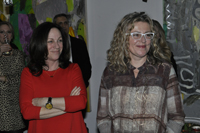 |
The Fine Art of Collecting Demystified We're not far into the new year, but by now many people's resolutions, including mine, have fallen apart. Yet there's one I always make, and keep: to buy at least one piece of art during the year. That might seem oh-so-easy for someone who writes about and makes art. It's not. |
 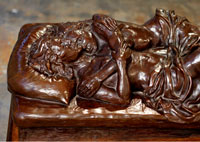 |
Patricia Cronin : Croninatrix New Yorker Patricia Cronin is a rare example of a female artist. We have discussed with her why such women are indeed a rare example and besides have talked about Riot Grrrl movement, about the role of the creative heritage and about life of a housewife as a comprehended choice. Having started to remember all the creative units among women, one can quickly exhaust his or her memory without even leaving the circle of musicians: Yoko Ono, Kim Gordon, Laurie Anderson - and the memory is beginning to slip . Persistently tries to challenge the status of our world as the men’s world - even in the aspect of art - Patricia Cronin , an artist, photographer , sculptor, Bachelor of Rhode Island College , Master (and now - a teacher) of Brooklyn College and former student of a few other schools. Dominant direction of her work is questioning the place of women in contemporary art, the role of her body, her sexuality and homosexuality. |
 |
Jeffrey Deitch Curates Jeffrey Deitch: “This is a crazy thing we did with Patricia Cronin,” he says, turning to a sculpture of two women in bed. “She wanted to have a show here. I said, ‘I’ve got a better idea. It shouldn’t be a show in a gallery. Let’s buy a cemetery plot.’ She said, ‘Well, I want a gallery show.’ ‘Trust me,’ I said. ‘This is much more interesting. It’s permanent.’ ” It’s a grave site for her and her partner in Woodlawn Cemetery. “It’s really transgressive to have in a cemetery. And this is now like one of the major stops on the Woodlawn Cemetery tour, with Miles Davis’s grave.” |
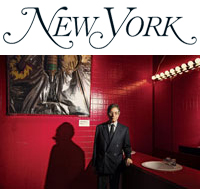 |
Selections from the Sara M. & Michelle Vance Waddell Collection The Art Academy is proud to announce a survey of work from the acclaimed and generous Sara M. Vance Waddell Collection. This exhibition is constructed to depict the main focus of their collection: challenging international work with political conviction. |
 |
Patricia Cronin elected President of the Society of Fellows Patricia Cronin elected President of the Society of Fellows and is now a trustee of the American Academy in Rome.
|
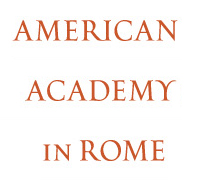 |
I fantasmi di Patricia Cronin
alla Centrale Montemartini
L’ultima ghostbuster è un’artista Americana del Massachusetts, venuta a Roma a miracol mostrare negli importenti spazi museali della Centrale Montemartini. Patricia Cronin non ha il fisico statuario di Sigourney Weaver ma una grazia luminoso e gentile e i misteriosi ectoplasmi lei non li cattura con raffinate tecnologie custodite nel suo zaino protonico; no, li dipinge e stampa su pannelli di seta translucida esibiti sui fondo nero dei giganteschi motori diesel dell’ex fabbrica. E, come se non bastasse, li fa dialogare nella Sala Macchine con le statue neoclassiche di un’altra artista americana scomparsa all’inizio del ‘900, Harriet Hosmer, da lei riscoperta e autrice della Tomba di Judith Falconnet nella Chiesa di Sant’ Andrea delle Fratte. È un salto mortale triplo, per esser chiari, questa personale Patricia Cronin. Le Macchine, gli Dei e I Fantasmi mirabilmente curata da Ludovico Pratesi e promossa da Roma Captiale (Musei Capitolini, Centrale Montemartini, in via Ostiense 106 fino al 20 novembre) sia per l’idea audace e insolita che per l’esito della relizzazione che, anziché degenerare in un clamoroso quanto probabile fiasco, le dà lo status del delitto perfetto. Sottolinea Pratesi “Queste opere sono fantasmi, hanno una presenza immateriale. Le immagini fluttuano nello spazio, creando e proponendo un nuovo dialogo tra il tempo, la memoria e il desiderio. La loro collocazione in tutto il museo crea un forte dialogo tra passato e presente, l’archeologia e l’industria e, naturalemente, l’arte contemporanea”.
|
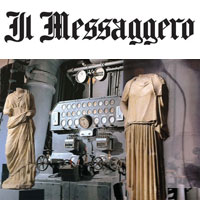 |
Come Together: Surviving Sandy
To commemorate the one year anniversary of Hurricane Sandy—and the resiliency of New York City’s arts community, which was hit especially hard by the storm—the Dedalus Foundation, the Brooklyn Rail, and the Jamestown Charitable Foundation join with Industry City Associates to present a nearly 100,000 square foot exhibition entitled Come Together: Surviving Sandy, Year 1. The exhibition will take place at Industry City, a hub of creative manufacturing and innovation in Sunset Park, Brooklyn. Centered on the work of artists directly affected by Sandy, the exhibition will also feature work inspired by and referring to the storm, along with work by artists who were invited to participate in the spirit of solidarity. In addition, the two-month exhibition will include musical performances, poetry readings, film screenings, and other cultural events. The Brooklyn Rail’s radio partner, ARTonAIR.org (the radio station of the Clocktower Gallery), will provide official radio coverage and music selections for the exhibition.
|
 |
The Unsinkable Art World
Interview Magazine
Around this time last year, Hurricane Sandy struck New York, causing massive, well-documented devastation. The art world was hit particularly hard. Water rose up to Chelsea, flooding galleries and decimating irreplaceable archives and artworks. Red Hook, a Brooklyn neighborhood dense with artists' studios, was almost completely submerged. Artists lost their space, their tools, and their work. But no one gave up—or even considered that an option. |
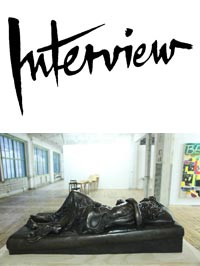 |
Patricia Cronin and the Ghosts of Rome Past
Patricia Cronin, FAAR’07, was back in Rome this month for the opening of her new exhibition, Machines, Gods and Ghosts, at the Centrale Montemartini Museum on via Ostiense. The show, which runs from October 10 to November 20, was curated by Ludovico Pratesi and constitutes the first exhibition of contemporary art to be held in this remarkable space. A panel discussion, hosted by the American Academy on October 7, offered important critical perspective on the show and members of the academy community turned out to demonstrate their support for the initiative at its opening reception two days later. Cronin is a Professor of Art at Brooklyn College City University of New York whose work has been exhibited widely in Europe and America. She is an artist with a strong commitment to social justice issues, particularly gay marriage rights and women’s history. Much of her work engages with memory or contemplates the role of remembrance and memorial. Her work has found its way into several permanent collections including the Corcoran Gallery in Washington, DC, Deutsche Bank in New York, and the Gallery of Modern Art in Glasgow. Most recently she has had solo exhibitions at the Ford Project Gallery in New York and the Newcomb Art Gallery of Tulane University in New Orleans. |
 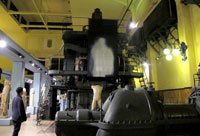 |
I sein mostra Patricia Cronin
Con opera monumentali
Sei opera monumentali, stampate su dei pannelli di seta traslucida inseriti, in modo suggestive, nello spazio di archeologia industrial della Centrale Montemartini. La mostra dell’artista Americana Patricia Cronin “Le Macchine, Gli Dei e I Fantasmi”, curate dal critic Ludovico Pratesi, si potrà vistare fino al 20 novembre. Le sie immagini, create appositamente per lo spazio industrial del museo, sono ispirate alla recente serie realizzata dall’artista e dedicate all rescoperta dell’artista neo classica Harriet Hosmer, autrice della tomba di Judith Falconnet nella chiesa di Sant’ Andrea delle Frattea Roma. |
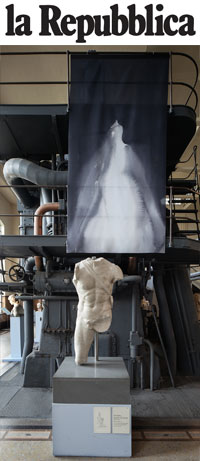 |
Dedicato a te, Harriet Hosmer
Operazione artistica concettualmente interessante, e oltretutto
realizzata in un ambiente, la vecchia e dismessa centrale elettrica
Montemartini di via Ostiense, da tempo trasformata in museo di
sculture antiche, talm ente straordinario che qualsiasi cosa ci
metti, di contemporaneo o meno, farebbe, come si dice in questi
casi, un figurone (il primo a consacrarla cinematograficamente,
l'ex Centrale, fu il regista turco Ferzan Ozpetek nel suo film «Le
fate ignoranti», dopodiché fu/è una sequela pressoché ininterrotta
di set, location, operazioni site specific ecc). |
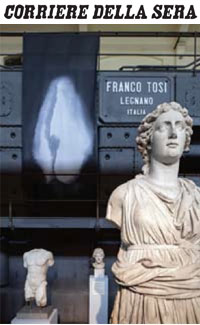 |
Patricia Cronin "Machines, Gods and Ghosts" From October 9th to November 20th 2013 in the suggestive rooms of the Centrale Montemartini in Rome will be held an exhibition of Patricia Cronin, "Machines, Gods and Ghosts": a new collection of works of the American artist, specially created for the museum.
|
  |
Patricia Cronin, FAAR'07, Ludovico Pratesi and Peter Benson Miller
discussion in English and Italian
Christopher S. Celenza, FAAR'94 requests the pleasure of your company at a conversation between Patricia Cronin, FAAR'07, Ludovico Pratesi and Peter Benson Miller discussion in English and Italian Monday 7 October 2013 at 6:30pm American Academy in Rome, Via Angelo Masina, 5 www.aarome.org on the occasion of the exhibition Le Macchine, Gli Dei e I Fantasmi at the Musei Capitolini Centrale Montemartini on 9 October 2013 at 6pm |
 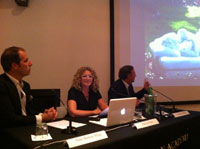 |
